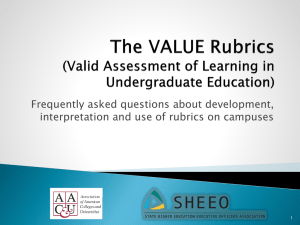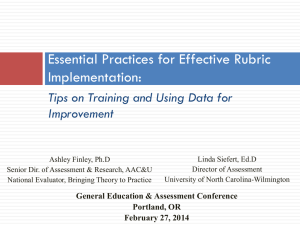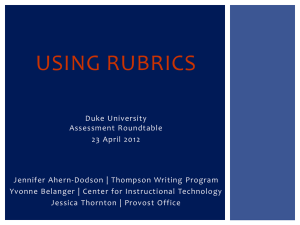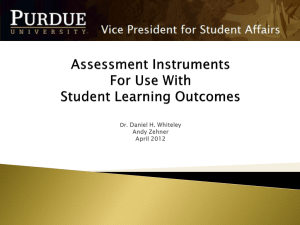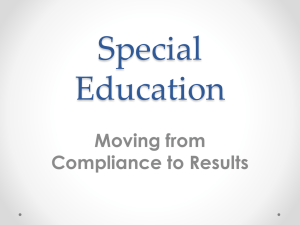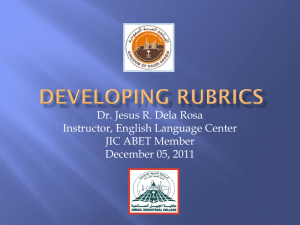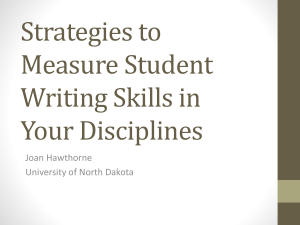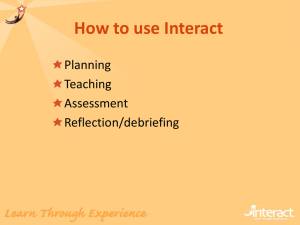Creating and Using Rubrics in the Active Learning Classroom
advertisement
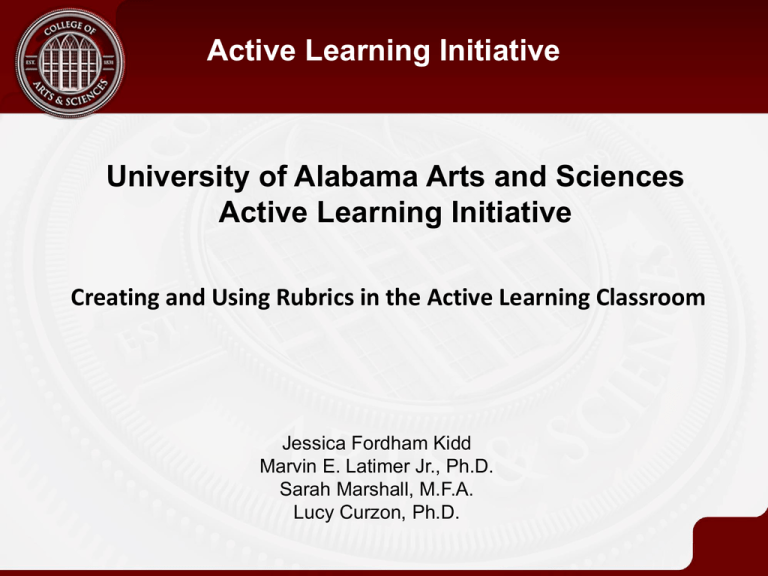
Active Learning Initiative University of Alabama Arts and Sciences Active Learning Initiative Creating and Using Rubrics in the Active Learning Classroom Jessica Fordham Kidd Marvin E. Latimer Jr., Ph.D. Sarah Marshall, M.F.A. Lucy Curzon, Ph.D. Workshop Overview: 1. Present Theoretical Overview 2. Introduce a writing exercise (“listing” or “clustering”) as an invention technique. 3. Show how clustering applies to rubric writing. 4. Create word clusters based on sample projects in your discipline. 5. Write a brief vignette that encapsulates values and areas you wish to emphasize. 6. Create draft rubrics based on these written vignettes. Relevant Theoretical Models (Back to the Future) • Capability Ability Clusters: • Imitative • Expressive/Interactive • Exploratory • Learning Theory-Humans learn better… • In groups • When included in decisions • When new information connects to old information • When we can relate learning to real life experiences • When we are happy! Assessment Measures (Back to the Future) • Shift from assessing rote learning and memorization to assessment of abilities (esp. higher order domains). • ALI focuses on affording students an opportunity to practice skills. • Ideally, this should happen prior to the final assessment. • Hence, the need to develop formative and summative assessment strategies. • Formative: during the learning process. • Summative: following the learning process. • Which leads us to……. Rubrics Defined Rubrics: • Are scoring tools that lay out the expectations for a specific assignment. • Divide an assignment into its component parts. • Provide discursive statements of what constitutes acceptable or unacceptable levels for each of those parts. • Usually are constructed using a matrix. Stevens, D. & Levi, A. (2005). Introduction to Rubrics. Sterling, VA: Stylus Publishing. Why Rubrics: Teacher Perspective • Efficiency, consistency, and objectivity (watch out here!). • Implicitly know what makes an assignment excellent, mediocre, or in need of improvement. • Evaluations more closely replicate real life experiences • Focus attention on the key concepts and standards that the students must obtain. • Provide the scaffolding necessary to improve the quality of students' work. • Increase the knowledge that the students acquire. • Allow teachers to accommodate heterogeneous classes by offering a range of quality levels (i.e., they can be used with broad ranges of students in the same class). http://www.teachersfirst.com/lessons/rubrics/why-use-rubrics.cfm Why Rubrics: Student Perspective • Clear understanding of what is expected of them. • Concrete directions about what makes a good science project, persuasive writing piece, art work, musical performance, etc. • Research has suggested that rubrics improve students' end products and thus increase the students' overall learning. • Provide students with valuable information about the degree of which a specific learning outcome has been achieved. • Concrete feedback that displays areas of strength and areas in need of improvement. • Students think about their own thinking and possibly about their own criteria for what is "good.” • Analyze their own work in relation to a standard. http://www.teachersfirst.com/lessons/rubrics/why-use-rubrics.cfm Basic Grid Format Stevens, D. & Levi, A. (2005). Introduction to Rubrics. Sterling, VA: Stylus Publishing. Constructing a Rubric Four Key Stages: • • • • Reflection… Listing/Clustering… Grouping and Labeling… Application… Stevens, D. & Levi, A. (2005). Introduction to Rubrics. Sterling, VA: Stylus Publishing. Alabama Vocal Association Ensemble Adjudication Form F4.3 RATING: Name of Ensemble: School: For Example District: Voicing: Number of singers : Grade Level(s): Performance Time and Date: 1st Piece: Title/Composer/Voicing: Adjudicator's Comments: 2nd Piece: Title/Composer/Voicing: 14 13 12 11 10 9 8 7 6 5 4 3 14 13 12 11 10 9 8 7 6 5 4 3 14 13 12 11 10 9 8 7 6 5 4 3 14 13 12 11 10 9 8 7 6 5 4 3 12 11 10 9 8 TONE: _______ out of 14 INTONATION: _______ out of 14 EXPRESSION: _______ out of 14 REVISED 2012 DICTION: _______ out of 14 7 6 5 4 3 REPERTOIRE: _______ out of 4 3 2 1 4 3 2 1 4 3 2 1 4 3 2 1 RHYTHM: _______ out of 4 NOTE ACCURACY: _______ out of 4 BALANCE: _______ out of 4 BLEND: _______ out of 4 Comments may be continued on the back 4 3 2 1 DISCIPLINE: _______ out of 4 TOTAL: _______ out of 88 SCORE CONVERSION: 88-73 = I rating; 72-55 = II rating; 54-37 = III rating; 36-20 = IV rating Adjudicator's Signature: WHY are you here? (our assumptions) • • • • You were attracted by the idea of improving your rubrics or feel a sense of dissatisfaction with those you already have in place. You feel some ambiguity about the usefulness of rubrics and are looking for persuasive evidence of their efficacy. Your professional situation dictates the implementation of rubrics for retention, accreditation, and quality enhancement. Coordinate departmental standards across a broad range (multiple sections of introductory courses, facilitate grading by multiple instructors). Creating Better Rubrics • Create rubrics that: • truly reflect your goals and values; the places that you find joy in teaching • incorporate students’ goals and values • encourage happy accidents, blundering, back-tracking, etc. (i.e., that don’t privilege only traditional, linear thinking). • facilitate peer and self-assessment • Find creative or innovative ways to measure and describe quality. Rubrics – Strengths • • • • • Provide structure when a wide field of possibilities can be overwhelming/paralyzing. Improve communication by providing common standards for evaluating performance. Introduce vocabulary and provide practice that are used useful skills for analyzing and evaluating (Bloom’s). Provide a tool for self-assessment before projects are critiqued/graded. Tease apart different components that go into the act of making/creating. Rubrics – Supporting Introverted Students http://www.thepowerofintroverts.com /about-the-book/ • Outlines research indicating that group dynamics strongly affect thought and behavior • Introverted students often lose their voice during group and collaborative learning activities. Rubrics – Weaknesses • • • • • Create a false sense of security when working, which evaporates when student works without the guidance of a rubric. Functions as a formula or algorithm, i.e., attempts to methodize the creative process. Potentially fruitful paths eliminated by attempt to move most efficiently to a given endpoint. Sense of conformity, being constrained or “boxed in”. Don’t acknowledge role of synergy in quality of final projects, i.e., doing well in all measures doesn’t always equal the best work. Rubrics – Gabrielle Rico • In teaching our students to be active learners, we often get the most done by tolerating ambiguity and resisting the desire to see ahead of time exactly where we are going. Rubrics – Clustering or Listing (Why?) • “Clustering” or spontaneous “listing” can bypass logical, orderly, linear qualities of thought. • Create connections that might not otherwise have occurred. • Generate ideas quickly by unfolding them from a central concept. • Explore associations BEFORE finalizing an order and structure. • Clustering or spontaneous listing works because it is a reflection of the way our mind naturally works. Rubrics – Clusters and Vignettes http://www.gabrielerico.com/Main/ClusteringSampleVignettes.htm Rubrics – Clustering/Listing Exercise • Choose a single word related to an assignment that you give to students, or related to studies in your discipline. • Write and circle the word in the upper third of the page, leaving the lower area for additional writing. • Write down all the words you associate with your beginning word. Work quickly, allow random associations, don’t selfcensor. • If you begin to focus on another word, cluster the associations around it. If you get stuck, doodle on your existing work. • You will know when to stop when you experience an “a-ha” moment or recognizing a pattern. Rubrics – Vignette Exercise • Begin writing in phrase/sentence form. • Refer to your cluster or ignore it completely; the process of making the cluster has created the patterns in your mind • Don’t feel that you must use everything in the cluster, or that you cannot add things that occur to you while writing. • Re-read (read aloud) the piece you’ve just written. You can focus more on your editorial voice at this point. • Stop when you have a strong sense that everything in your vignette “belongs”. Rubrics – Vignette to Rubric • Using the other side of the page, fit your vignette into the rubric table. • Label your axes and fill in descriptions. • Dimensions (things being measured) (going across) • Rankings (standards for measuring) (going down) • Criteria (descriptions of standards) (fill in grid) Skill Excellent Fair Poor Vocabulary Synthesis

